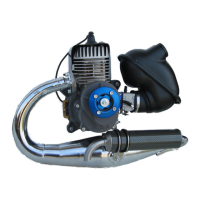Pag. 4
1.1 BASIC OPERATION
• In the 2-stroke motors like the Snap100, is of absolute importance the corrected
carburation to avoid seizure to the piston (not covered from guarantee).
Start the Engine
WARNING
• Never run the engine in an enclosed
area. The exhaust contains poisonous
carbon monoxide gas that can cause
loss of consciousness and may lead to
death.
• Attempting to start the engine without
the riducer provokes the outbreak of
the clutch and can cause injury or
damages.
• Never run the engine without
propeller.
• The starter attempt can carry to the
spin of the propeller and therefore to
possible lesions.
• The motor running emits disturbs
electromagnetic.
Cold Engine Starting:
1. To carry in pressue the circuit of
the gasoline, to help itself
pressing the push-button (fig.2).
2. To appeal the starter and to
delicately pull iust after the harder
point (to try repeatedly for being
sure).
3. To pull the grip with energy,
without throttle in. .
4. In case of lacked starter to repeat
the procedure without to
accelerate .
5. Allow the engine to warm up for
at least 2 minutes before riding
off,
6. . Slowly increase rpm and don’t
grip the throttle warming the
engine is important to prevent
cold seizures
Warm Engine Starting:
1. To appeal the starter and to delicately
pull hardly after the harder point
2. To pull the grip with energy, without
throttle in.
Stopping The Engine
1. Depress and hold the engine stop button
until the engine stops completely
Break-in Procedure :
Following proper break-in procedure helps
censure that some of the most important and
expensive components on your new Snap100
will provide maximum performance and service
life. (Also follow proper break-in procedure for a
newly rebuilt engine)
1. Do not hold the throttle in one
position for more than a few
seconds. It’s better to roll the
throttle on and off, without
gaining too much,height and
forcing too much at the motor.
2. Use the motor for features of 10
minutes at a time and to leave to
cool it.
3. After two hours of use or
approximately 10 liters of
gasoline the motor should be
broken in.
4. This same procedure should be
followed each time
• Piston is replaced
• Cylinder is replaced
• Crankshaft or crank bearings are replaced

